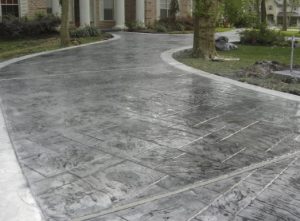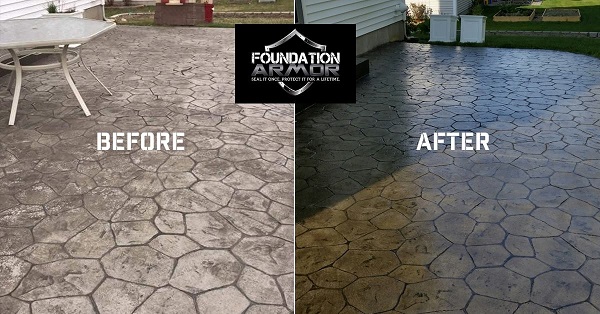Wet look might mean one thing to you and something completely different to your neighbor which is why choosing the best wet look concrete sealer comes down to understanding how wet look sealers work.
There are two types of wet look concrete sealers. There are wet look concrete sealers that darken the surface of the concrete to make it look wet, and there are wet look concrete sealers that won’t darken the surface of the concrete but will enhance the concrete with a high gloss finish. What you want your concrete to look like once sealed will determine which type of wet look sealer you need for your concrete.
True Wet Look Finish
If you like what your concrete looks like when wet, or if you want to bring out any dull and faded coloring, then you want a solvent based acrylic sealer. The resins in the solvent based acrylic sealers are designed to darken the surface and make it look wet. We pulled the above photo from Foundation Armor because they have very accurately showed what a true wet look concrete sealer will do to your concrete. The product featured in the photo is the Armor AR350 which is a satin gloss wet look sealer. The company also offers the Armor AR500 which is a high gloss variation of the  AR350.
AR350.
- Eagle High Gloss Sealer (average 4.6 star review)
- Armor AR350 Wet Look Sealer (average 4.8 star review)
- Armor AR500 High Gloss Sealer (average 4.9 star review)
- Enduraseal SB Acrylic Sealer (average 4.5 star review)
High Gloss Shine
If you want a high gloss finish but don’t want the surface of the concrete darkened then you want a water based acrylic sealer. Most water based acrylic sealers will provide a high gloss shine without darkening the concrete to make it look wet.
- Seal-Krete Clear Seal Acrylic Sealer (average 4 star review)
- Armor WB25 Acrylic Sealer (average 4.9 star review)
Wet Look Concrete Sealer Comparison
As mentioned above, the two best wet look sealers are water based and solvent based acrylic sealers. Aside from what they make the concrete look like once sealed, there are a few other differences.
| Water Based Acrylic Sealers | Solvent Based Acrylic Sealers |
| Won’t darken the concrete | Will darken the concrete |
| Repaired by screen sanding | Repaired with Xylene |
| Requires screen sanding before recoat | No prep required for recoat |
| Can’t add a non slip additive | Can add a non slip additive |
| No VOC | Low VOC |
The second main difference between water and solvent based acrylic sealers is repair and maintenance. Solvent based acrylic sealers can easily be repaired with Xylene, and when it comes time to re-coat you simply put more acrylic sealer down to a clean and dry surface. Water based acrylic sealers however often require screen sanding, and in severe cases, removal. Both types of acrylic sealers will protect and enhance the concrete.
Re-coating a Wet Look Concrete Sealer
If your concrete is currently sealed with a wet look sealer then you need to make sure that the new sealer is compatible with the old sealer. Water based acrylic sealers need to be re-coated with a water based acrylic sealer, and solvent based acrylic sealers need to be re-coated with a solvent based acrylic sealer. Mixing the two will result in failure of the new and old sealer. You can mix brands, but you can’t mix water based with solvent based.
It is important to also take into consideration the type of acrylic sealer. Under the category of acrylic sealers there are acrylic lacquer sealers, acrylic co-polymer sealers, and acrylic latex sealers. There are no issues with acrylic lacquer sealers and acrylic co-polymers sealers and those can easily re-coat the other, but there are issues with an acrylic latex sealers. Acrylic latex sealers contain latex and aren’t breathable, and they also function more like a paint than a sealer. Acrylic latex sealers are only compatible with acrylic latex sealers, and if given the choice, should be avoided at all costs. They may contain an acrylic resin, but acrylic latex sealers don’t function like an acrylic at all.

